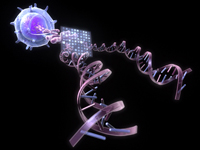Fundamental genes regulate human blood stem cells

Credit: Dr. Mickie Bhatia
A study published in the May issue of Developmental Cell identifies specific genes that appear to be key players in the regulation of human-blood stem cells. This work is the first to validate gene expression analysis in human stem cells with functional experiments. The findings also suggest that changes in the expression of genes associated with universal cell signaling pathways can have a substantial impact on human stem cell behavior.
Formation and ongoing maintenance of blood cells begins with a rare cell called a hematopoietic stem cell (HSC) that has the ability to make more copies of itself or differentiate into progenitors that then form red blood cells, various types of white blood cells, or platelets. Blood cells must be constantly renewed throughout the lifetime of an animal, so control and regulation of HSCs is critical for survival. Although it is clear that the capacity for HSC proliferation and differentiation declines with age, not much is known about exactly how HSC physiology is regulated.
Dr. Mickie Bhatia and colleagues from the Robarts Research Institute in Ontario used genome-wide gene-expression profiling (microarray analysis) to examine purified subsets of defined blood-cell populations containing progenitors or HSCs from multiple stages of human development. The researchers identified two genes that act independently to enhance cell-cycle progression and inhibit cell death specifically in HSCs. The role of one gene, HES-1, ties in with previous research pointing to the importance of the cell-cycle-associated Notch signaling pathway. The second gene, HLF, is a DNA-binding transcription factor involved in preventing premature HSC death. Bhatia and colleagues showed that raising the amount of either gene in human HSCs increased their capacity for forming blood cells when they were transferred into mice.
The researchers conclude that HES-1 and HLF are regulators of HSC behavior. Because HES-1 and HLF impact HSC function via two different mechanisms involving integral pathways common to all human cells, the authors suggest that HSC behavior may be controlled by general rather than HSC-specific genes. “Our report identifies regulatory factors involved in HSC function that elicit their effect through independent systems and suggest that a unique orchestration of pathways fundamental to all human cells is capable of controlling stem cell behavior,” explains Dr. Bhatia.
Media Contact
More Information:
http://www.cell.comAll latest news from the category: Life Sciences and Chemistry
Articles and reports from the Life Sciences and chemistry area deal with applied and basic research into modern biology, chemistry and human medicine.
Valuable information can be found on a range of life sciences fields including bacteriology, biochemistry, bionics, bioinformatics, biophysics, biotechnology, genetics, geobotany, human biology, marine biology, microbiology, molecular biology, cellular biology, zoology, bioinorganic chemistry, microchemistry and environmental chemistry.
Newest articles

Silicon Carbide Innovation Alliance to drive industrial-scale semiconductor work
Known for its ability to withstand extreme environments and high voltages, silicon carbide (SiC) is a semiconducting material made up of silicon and carbon atoms arranged into crystals that is…

New SPECT/CT technique shows impressive biomarker identification
…offers increased access for prostate cancer patients. A novel SPECT/CT acquisition method can accurately detect radiopharmaceutical biodistribution in a convenient manner for prostate cancer patients, opening the door for more…

How 3D printers can give robots a soft touch
Soft skin coverings and touch sensors have emerged as a promising feature for robots that are both safer and more intuitive for human interaction, but they are expensive and difficult…





















